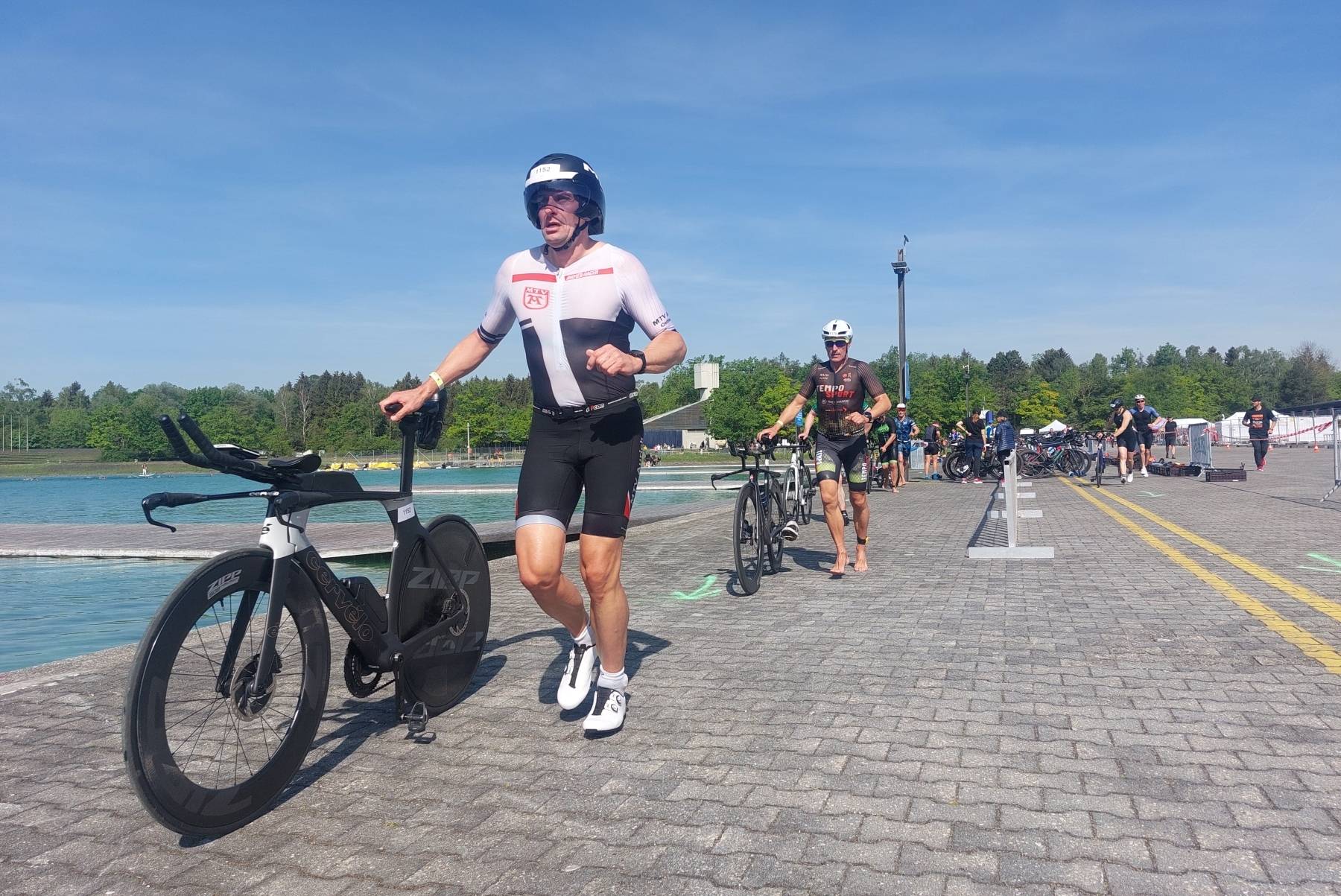Wie gut sich ein Athlet von einer Disziplin auf die nächste umstellen kann, ist eine leistungsbestimmende Fähigkeit im Triathlon. Mit einem Koppeltraining, einer Trainingseinheit die sonst in kaum einer anderen Sportart durchgeführt wird, kann diese Fähigkeit trainiert werden.
Begriffsunterscheidung Koppeltraining - Wechseltraining
Koppeltraining = Training zweier / mehrerer Disziplinen in unmittelbarem Zusammenhang mit dem Ziel der Verbesserung der muskulären, nervalen und energetischen Umstellungsfähigkeit des Körpers.
Wechseltraining = Training der Abläufe zwischen den Disziplinen mit dem Ziel der Verbesserung und Optimierung der Tätigkeiten und Handgriffe.
Das Koppeltraining kann für den Übergang vom Schwimmen zum Radfahren und vom Radfahren zum Laufen trainiert werden. Da das Schwimmen aufgrund anderer muskulärer Beanspruchung jedoch relativ wenig Einfluss auf die nachfolgende Disziplin hat, spielt der Übergang Schwimmen-Rad keine große Rolle für das Koppeltraining. Viel wichtiger ist der Übergang Rad-Laufen.
Warum Laufen nach dem Radfahren, nicht einfach nur Laufen ist
Aufgrund der Vorbelastung durch das Radfahren findet das Laufen im Triathlon unter besonderen Voraussetzungen statt. Zum einen liegt bereits zu Beginn ein gewisser Ermüdungsgrad der Muskulatur und eine Entleerung der Energiespeicher vor. Zum anderen ist die neuromuskuläre Bewegungskoordination beim Radfahren und Laufen sehr unterschiedlich. Die Ansteuerung der Muskulatur muss also zu Beginn des Laufens möglichst schnell umgestellt werden.
Ziel des Koppeltrainings ist es diese Umstellung vom Radfahren zum Laufen möglichst schnell und effizient zu machen. Es werden die neuromuskulären Voraussetzungen für höhere Geschwindigkeiten beim Laufen entwickelt und ein möglichst ökonomischer Laufstil unter Ermüdung trainiert. In Kombination mit einem Wechseltraining kann zusätzlich der Wechselvorgang optimiert werden.
Auch Koppeln ist nicht gleich Koppeln
Das Koppeltraining kann wie das sonstige Training auch in verschiedene Intensitätsbereiche unterteilt werden. Dem GA1-Training kann man das Koppeltraining 1 (KT1), dem GA2-Training das Koppeltraining 2 (KT2) und dem wettkampfspezifischen Training das Koppeltraining 3 (KT3) zuordnen. Im Verlauf eines Trainingsjahres kann das Koppeltraining vom unspezifischen Koppeltraining im Intensitätsbereich 1 über das semispezifische Koppeltraining in den Intensitätsbereichen 1 und 2 zum spezifischen Koppeltraining in den Intensitätsbereichen 2 und 3 durchlaufen werden (siehe Grafik).
Die verschiedenen Intensitätsbereiche können auch innerhalb einer Koppeltrainingseinheit variiert werden, um zum Beispiel eine gewisse Vorbelastung zu simulieren. Zum Beispiel könnte sich eine Einheit aus einer langen Radeinheit im GA1-Bereich und einem anschließenden kurzen Lauf im GA2-Bereich zusammensetzen. Durch die Vielzahl an Gestaltungsmöglichkeiten kann man sehr gut die Stärken und Schwächen eines Athleten berücksichtigen.
Beispieleinheiten
| Kategorie | Intensität | Sportarten | Beispiel | Hinweis |
| Unspezifisch | KT1 | Ski-LL, MTB | 10km Ski-LL GA1 + 25km MTB GA1 | 30min locker Ausfahren |
| Semispezifisch | KT1/2 | MTB, Lauf | 50km MTB GA1 + 5km Lauf GA2 | 15min Auslaufen |
| Semispezifisch | KT2/2/1 | Lauf, Rad, Lauf | 5km Lauf GA2 + 10km Rad GA2 + 5km Lauf GA1 | Aufwärmen |
| Spezifisch | KT2 | Rad, Lauf | 2x (10km Rad GA2 + 5km Lauf GA2) | Pause 30min locker Radfahren |
| Spezifisch | KT2/3 | Rad, Lauf | 3-4x (5km Rad GA2 + 1km Lauf WSA) | Pause 5min locker Laufen od. Radfahren |
| Spezifisch | KT1/3 | Rad, Lauf | 80km Rad GA1 + 2km Lauf WSA | 15min Auslaufen |
Must-Haves für den Triathlon
Dieses Zubehör macht das Leben eines jeden Triathleten deutlich leichter!




















